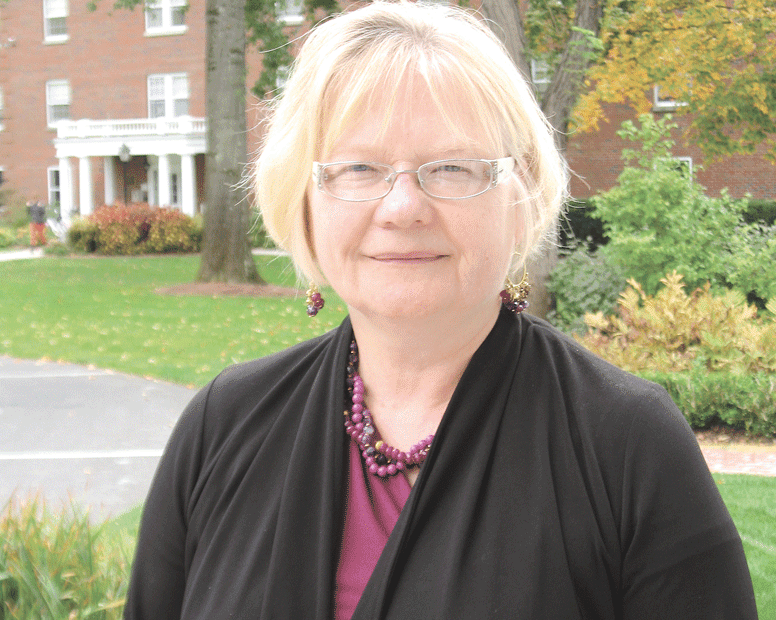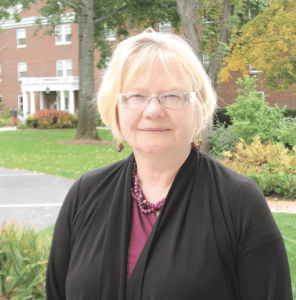
Back to School
Colleges Tout the Value of Degrees in Nonprofit Management
“No money, no mission.”That’s a commonly heard saying in the Nonprofit Management and Philanthropy graduate program at Bay Path College, a catchphrase repeated by professors and absorbed by students, many of whom already work for nonprofit organizations.
“You have to be able to manage the bottom line to fund your mission,” said Melissa Morriss-Olson, a professor in the program and Bay Path’s provost and vice president for Academic Affairs. “If you lose sight of that, all the good you want to do is not going to happen. You can’t have one without the other.”
Nonprofit organizations face tough sledding these days — with the economy sluggish and societal needs on the rise, fund-raising and program implementation is more difficult than it used to be (see story, page 16), and nonprofits increasingly realize that to compete and thrive in this environment, they have to run like for-profit businesses. One way that trend manifests itself is a proliferation in college degree programs centered on nonprofit management.
“I had founded a similar program in Chicago, one of the first academic centers for nonprofit management in the country,” Morriss-Olson said. “At the time, there were maybe 30 graduate programs in that field, and now there are well over 100 — and more than 300 colleges offer some kind of course in nonprofit management.
“That increase reflects a growing awareness of the nonprofit sector,” she continued. “It used to be that you fell into a job in the nonprofit sector; now it’s a much more well-defined career path for people who want to work in the sector. It’s everywhere in our country; in this area alone, probably once a month, a new nonprofit is starting.”
Kathryn Carlson Heler, director of the Master of Business Administration (MBA) program at Springfield College, said such programs are attractive not only to executives and employees of nonprofits who want to advance their skills and improve their organizations, but young people and older career changers alike who are looking to launch new enterprises or take roles in established ones.
“It’s a wonderful time for people to get an education in the nonprofit world because there are so many upcoming openings in the field,” she noted. “So many of the executives are looking forward to retirement, and there’s no one behind them.”
That said, “I’ve found that a business background is a perfect background for people in the nonprofit realm, because a nonprofit is a business — a business with a mission — and having the knowledge and skills to run a business is so important.”
Bay Path and Springfield are two area schools that have created graduate programs in nonprofit management, launching their efforts in 2006 and 2010, respectively. In this issue, BusinessWest examines the different shades of such programs — and why nonprofits, and those who lead them, are starting to take notice.
Different Flavors
Bay Path actually offers two separate degree programs for nonprofit professionals and those who want to get into some aspect of that world.
“One is an MS in Nonprofit Management and Philanthropy, and one is an MS in Strategic Fundraising and Philanthropy,” Morriss-Olson said. “They are distinct, both in the type of student who enrolls and the careers that each leads to.
The MS in Nonprofit Management and Philanthropy, she noted, is geared toward those who see themselves in a management role, such as executive director, director of operations, or chief financial officer. “It gives you a really good foundation for understanding the unique management and operating context that nonprofits have.
“When I came here,” she explained, “rather than just taking the Chicago program and dumping it at Bay Path, we convened a group of about 30 nonprofit leaders in the region. We invited them to campus and discussed what they saw as the more critical leadership needs of their organizations. We took that and turned it into an advisory group, and the courses are a direct response to what those leaders told us.”
Class topics range from board governance to strategic management; from finances to law and policy matters.
“One of the biggest issues we heard is the need to know how to manage a double bottom line — being not only financially viable, but also effective in realizing the mission,” Morriss-Olson said. “In the business world, you just worry about the bottom line, but in the nonprofit world, that’s not enough. You need to be mission-driven but also smart from a financial perspective.”
That unique perspective, she explained, informs the foundation of all the courses offered. “That emphasis is the focus of every single course you take, so when you graduate, you really are schooled in management issues through the lens of that unique operating context.”
Bay Path’s other track in nonprofit education is an MS in Strategic Fundraising and Philanthropy, and it was developed after the first degree program after students began requesting more coursework in fund-raising,” she explained. The program certainly provides that, with classes in communication and relationships, donor behavior, grant writing and foundation relations, capital campaigns, planned giving, and more. “Fund-raising and getting revenue is so critical for these organizations, and they want to know as much about it as they can.”
Springfield College included Nonprofit Management as a concentration in its MBA program launched just two years ago. The track is attractive to people eyeing opportunities in health care, recreation, youth, the arts, sports, and as fund-development officers, to name just a few possible career paths.
In creating a two-pronged MBA program, “we looked at what areas would be common between a for-profit business and a nonprofit, and we have a number of courses that both types of students take,” Carlson Heler said. “Those include courses on entrepreneurship, financial management, accounting, economics, and marketing. And then there are a couple of areas that are very specific to nonprofits; one is fund-raising and philanthropy, and another is governance of an organization, so we developed courses that focus on those.”
The overlap is natural, she said, at a time when nonprofits need to become more bottom-line-driven to survive.
“Foundations and corporations that donate are beginning to say, ‘we want the nonprofits who receive our money to be run like a business; we don’t want our money to be wasted,’” she noted.
Citing the research of Dennis Young of Case Western Reserve University in Cleveland, Carlson Heler noted that there are two different classes of nonprofits. One comprises bodies that come together to meet an immediate need over a finite period of time; the groups that responded to Springfield’s tornado destruction last year are a good example.
“Then there’s the nonprofit that’s a real business. They need all those business skills because they’re competing not only for dollars, but also for customers.”
Even colleges that don’t specifically offer nonprofit management degrees recognize the overlap. David Stawacz, assistant vice president for Marketing and External Affairs at Western New England University, said MBA programs in general are valued in the nonprofit world.
“It’s the most recognized degree,” he said. “The skills you pick up in an MBA are readily transferable to running a nonprofit — strategic planning, qualitative analysis, leadership, finance, marketing, even organizational behavior. It’s not the same as running a for-profit business and going to shareholders, but you still need to have all those pieces of the puzzle in place.”
WNEU has seen the interests of the business and nonprofit communities interlock in other ways, too, including its eight-week Leadership Institute offered from February through April each year in conjunction with the Affiliated Chambers of Commerce of Greater Springfield.
“A lot of our MBA faculty teach the workshop. Once a week, people take one afternoon off a week and go downtown and focus on leadership and strategic thinking,” Stawacz said. “It’s open to all, and it was geared in the beginning toward business, but a lot of nonprofit organizations found it valuable, and it has grown quite popular with some of the nonprofits.
“It has a lot of the same principles behind an MBA, but in a much shorter time, with a much broader view of things,” he added. “In eight weeks, you can only accomplish so much, but there are definitely a lot of skills you can take back to a business or nonprofit. It also helps with networking opportunities between the nonprofit world and the business world.”
Moving On Up
Morriss-Olson said many nonprofit employees see a degree in philanthropy studies as a sort of career ladder.
“We get a lot of people, in both degrees, who have worked their way up, then got to the point where they realized they needed a graduate degree to jump to the next level. And we have executives who may not need the degree, but want to add to their experience,” she said, adding that they’re finding it to be a worthwhile endeavor.
“They tell me, ‘finally I’ve got a vocabulary to help me understand the work I’ve been doing all these years.’ The coursework has helped them frame their own experiences in a way they find very helpful.”
It also helps them develop new strategies for dealing with the myriad demands placed on nonprofits today.
For many just entering the field, she said, “what surprises them is how much time and attention they have to spend managing constituencies, whether it’s community leaders, board volunteers, donors, client families — it goes on and on. We have a course in the curriculum on board governance and volunteer management; it focuses on how to recruit and then effectively manage a board, but also how to effectively deal with the volunteers who will help you with your mission.”
But it’s not only established professionals who are signing up for the degree. “A number of our students want to start nonprofit organizations, and they’ve found that enrolling in this program is a great way to get help doing that,” she continued. “One of the wonderful things about our country is, if you have an interest and want to do some good, it’s very easy to get together and get state and federal recognition for your cause,” she said.
In either case, Morriss-Olson said, it helps that many courses are taught by actual nonprofit executives who bring real-world experience to the classroom. “That’s helping us marry theory to practice.”
Carlson Heler said enrollment in the nonprofit side of Springfield College’s MBA program is low, but growing steadily. “As I go around and talk about it, more and more individuals are interested in the degree and see its worth,” she said, adding, however, that efforts to boost the numbers encounter two problems.
“One is that the nonprofit world has, in the past, relied heavily on workshops and conferences to pass along the knowledge that is needed to run a nonprofit,” she explained, “and people have the attitude of, ‘well, I can just go to a workshop on how to do an audit, or a workshop on how to market my program,’ instead of thinking, ‘hey, how about a degree?’
“The second thing,” she continued, “is that it costs money to get a graduate degree. It can be expensive, and a lot of nonprofits do not have the funds to send their people back to school.”
She hopes that’s changing. “I have a wonderful student out of Connecticut who is an executive director; her board is paying her whole way because they do see the benefit.”
As those benefits become more apparent, expect enrollment to rise — not only locally, but across the country. After all, knowledge is power, and nonprofit organizations fighting for every dollar can never have too much of that.
Joseph Bednar can be reached at [email protected]





